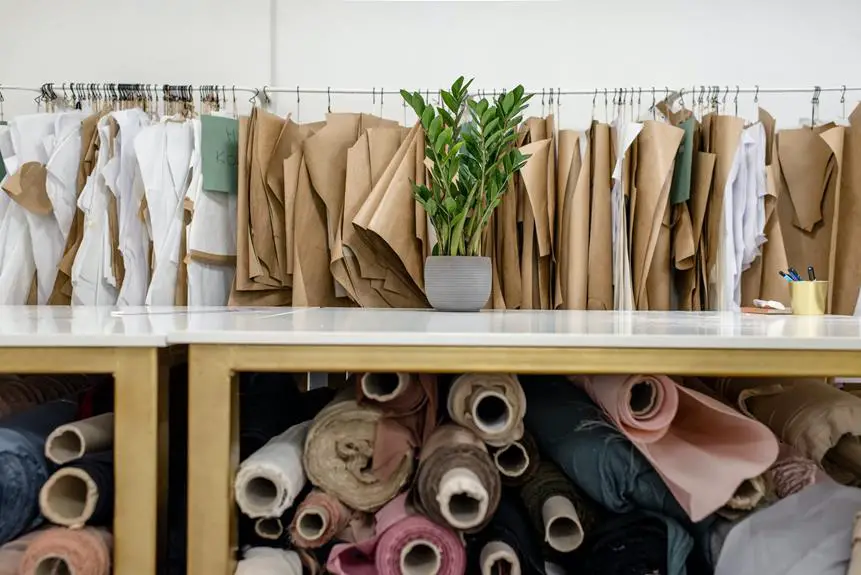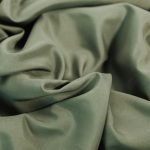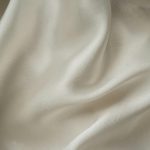When it comes to choosing the perfect fabric for your project, the decision can feel like navigating through a maze of options. Understanding the differences between crepe satin and regular satin is crucial for achieving the desired outcome.
You'll want to consider factors such as drape, texture, and sheen to make an informed choice. The right fabric can elevate your creation to new heights, and that's where mastering the differences between these two fabrics becomes essential.
Let's delve into the distinctive qualities of crepe satin and regular satin so that you can confidently select the ideal fabric for your next endeavor.
Key Takeaways
- Crepe satin offers a distinct matte finish, subtle crepe texture, and unique luster, adding depth and dimension to designs.
- Crepe satin has a softer and lighter drape compared to regular satin.
- Regular satin has a smooth and glossy surface, luxurious sheen, and is versatile for various applications.
- Regular satin has a firmer drape and structured appearance.
Key Characteristics of Crepe Satin
When choosing crepe satin, consider its distinct matte finish and subtle crepe texture for a sophisticated and versatile fabric. Crepe satin has a unique luster that sets it apart from traditional satin. The matte finish gives it a refined and elegant appearance, perfect for creating luxurious garments and elegant drapery. The crepe texture adds depth and dimension to the fabric, making it visually appealing and adding a touch of sophistication to any design.
One of the key characteristics of crepe satin is its drape. The fabric has a graceful and fluid drape, allowing it to hang beautifully and flow effortlessly, making it an ideal choice for flowing dresses, skirts, and evening gowns. The drape of crepe satin adds a sense of movement and fluidity to the garment, enhancing its overall aesthetic.
The luster of crepe satin, combined with its exquisite drape characteristics, makes it a sought-after fabric for formal wear and special occasions. Its versatility allows for a wide range of design possibilities, from elegant evening wear to chic everyday attire. When seeking a fabric that exudes sophistication and offers exceptional drape, crepe satin is an excellent choice.
Advantages of Regular Satin
If you're looking for a fabric with a smooth, glossy surface, regular satin offers a classic, elegant option that contrasts with the matte finish and subtle texture of crepe satin.
One of the key advantages of regular satin is its smooth texture, which feels luxurious against the skin. The weaving technique of regular satin creates a lustrous front surface with a dull back, giving it a beautiful sheen that reflects light in a captivating manner. This luxurious sheen makes regular satin a popular choice for formal attire, lingerie, and luxurious bedding.
Additionally, the smooth texture of regular satin makes it incredibly comfortable to wear, draping beautifully and feeling soft to the touch.
The fabric's inherent elegance and timeless appeal make it a versatile choice for various fashion and home decor applications. Its ability to effortlessly elevate any design with its luxurious sheen and smooth texture makes regular satin a go-to option for those seeking a sophisticated and polished look.
Differences in Draping and Texture
When selecting between crepe satin and regular satin, consider the differences in draping and texture to make the right choice for your project.
Crepe satin is known for its slightly crinkled texture, which gives it a more matte appearance compared to the smooth and glossy finish of regular satin. This difference in texture affects how the fabrics drape.
Crepe satin tends to drape more fluidly and has a softer, more relaxed look, making it ideal for flowing garments like dresses and blouses. On the other hand, regular satin has a firmer drape and a more structured appearance, making it suitable for garments requiring more body and shape, such as tailored jackets or skirts.
Another consideration when comparing the draping and texture of these fabrics is their weights. Crepe satin is generally lighter in weight compared to regular satin, which can impact the way the fabric hangs and moves.
When utilizing draping techniques in your project, the weight of the fabric plays a crucial role in achieving the desired look and feel. Understanding these differences in draping and texture will help you select the most suitable fabric for your specific design needs.
Choosing the Right Fabric for Your Project
Consider the specific requirements of your project when choosing between crepe satin and regular satin. The right fabric selection is crucial for the success of your project, so let's delve into the key factors to consider:
- Fabric Selection
- Fiber Content: Evaluate whether your project requires a specific fiber content, such as silk, polyester, or a blend.
- Color and Print: Determine if the fabric needs to be solid-colored, printed, or dyed, based on your project's design requirements.
- Texture and Finish: Consider the tactile and visual aspects of the fabric to ensure it aligns with your project's aesthetic.
When it comes to project suitability, think about the following:
- Project Suitability
- Drape and Flow: Assess if your project calls for a fabric with a fluid drape or one that holds its shape more firmly.
- Durability and Care: Consider the level of care and maintenance the fabric will require based on the project's intended use.
- Environmental Factors: Take into account the environmental conditions your project will be exposed to, such as humidity or temperature.
Care and Maintenance Tips for Both Fabrics
For maintaining both crepe satin and regular satin, you should follow specific care instructions to ensure their longevity and quality.
When it comes to cleaning, it's best to hand wash both types of satin in cold water with a gentle detergent. Avoid wringing or twisting the fabric and instead gently press out the excess water before laying it flat to dry. If machine washing is necessary, use a delicate cycle and a mesh laundry bag to protect the fabric.
When it comes to ironing, use a low heat setting and place a pressing cloth between the iron and the fabric to prevent any damage. Alternatively, consider steaming the fabric to remove wrinkles and maintain its luster.
Proper storage is also essential for preserving the quality of both crepe satin and regular satin. Store them in a cool, dry place away from direct sunlight and avoid hanging them to prevent stretching.
Frequently Asked Questions
Can Crepe Satin and Regular Satin Be Used Interchangeably in Sewing Projects?
Yes, crepe satin and regular satin can be used interchangeably in sewing projects. Consider fabric suitability, cost, and dyeing techniques. Combining textures creates unique effects. Experiment to discover which fabric works best for you.
Are There Any Specific Types of Garments That Crepe Satin Is Best Suited for Compared to Regular Satin?
When choosing between crepe satin and regular satin, consider the garment suitability. While these fabrics can be used interchangeably, crepe satin's texture is ideal for structured garments like blazers and pencil skirts, whereas regular satin suits flowing designs like evening gowns.
How Does the Cost of Crepe Satin Compare to Regular Satin?
When comparing the cost of crepe satin to regular satin, you'll find that crepe satin is often more expensive due to its intricate weaving process. However, availability can vary based on demand and production.
Are There Any Specific Dyeing Techniques That Work Better on Crepe Satin Versus Regular Satin?
When dyeing crepe satin and regular satin, consider their fabric properties. Crepe satin's textured surface may result in a more uneven dye application, while regular satin's smoothness allows for a more consistent color absorption.
Can Crepe Satin and Regular Satin Be Combined in a Single Garment for a Unique Texture and Drape Effect?
Yes, you can combine crepe satin and regular satin in a single garment for a unique texture and drape effect. The versatility of these fabrics allows for creative combinations, offering a visually appealing and distinct look.
- Can You Wear Guipure Lace to the Office? A Guide to Professional Styling - June 25, 2025
- Beyond Clothing: Creative Uses for Guipure Lace in Home Decor - June 25, 2025
- Accessorizing With Guipure Lace: From Collars to Cuffs - June 25, 2025







